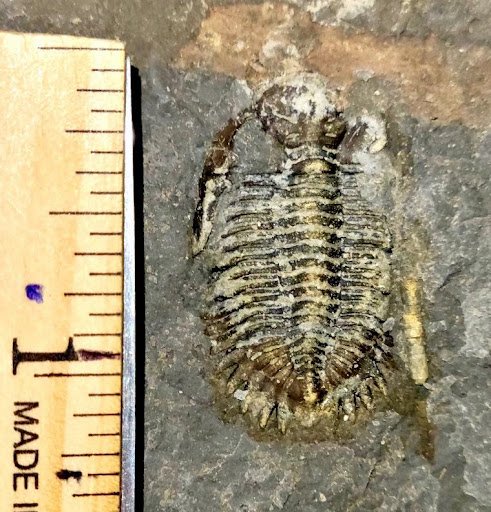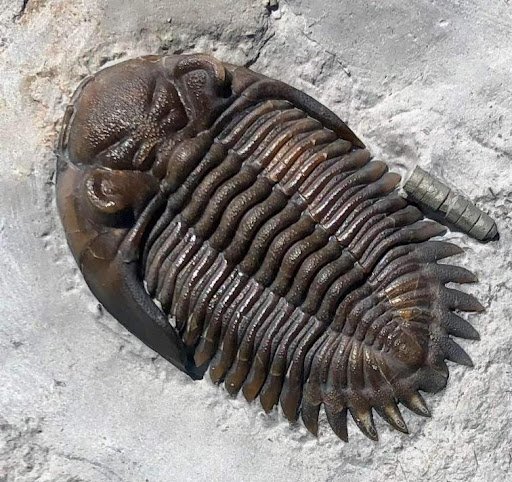The fossils at Hungry Hollow in North Middlesex are mid-Devonian in age (between 393-382 million years), during a time known as the Age of Fishes. There was a warm shallow inland saltwater sea that covered Southern Ontario, making it the perfect environment for crinoids, trilobites, starfish, corals, and many more organisms. Part of the fossil-bearing area was exposed by geological processes and melt waters from retreating glaciers that carved out the gorge at Rock Glen Conservation Area.
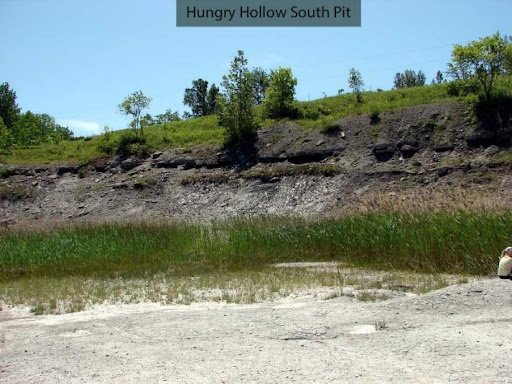
Years ago, shales from the locally-exposed Arkona Formation were quarried for the production of drainage tiles and brick, resulting in the two quarries that are still present today. These quarries are called the Hungry Hollow North pit and South pit, and they expose a handful of sometimes fossiliferous rock layers from the mid-Devonian Period. Both quarries are presently owned by a brick company.
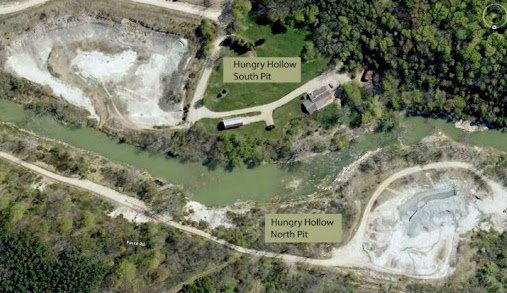
Over 150 years of fossil hunting in the Arkona area, including many visits by well-known paleontologists has made Hungry Hollow famous worldwide. American paleontologist James Hall studied many fossils from Hungry Hollow such as a common coral, Heliophyllum halli, which was named after him. Another American paleontologist, Niles Eldredge, also has a local fossilized organism named after him, a trilobite called Eldredgeops.
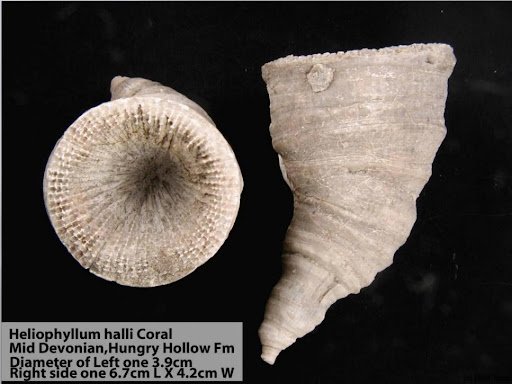
Charles Southworth was a very well-known fossil collector that lived in the nearby town of Thedford. He collected so often at Hungry Hollow that he became an expert on fossils in the area. As such, many professional paleontologists sought his advice when visiting the quarries. Several fossils are named after him, such as Phacops iowensis southworthi, a rare trilobite species found in Hungry Hollow.

Today, many fossil enthusiasts come to the Hungry Hollow quarries to dig. Two brothers from Michigan, Mike and John Topor, have visited the area over 500 times, and have found numerous holotype fossils (holotype fossils are the first of that species to be found and described). One of these holotype fossils is a pyritized polychaete worm that was subsequently named after the town of Arkona and the Topor brothers themselves, Arkonips topororum. Another amazing fossil they found is a 28-armed starfish named Arkonaster topororum.
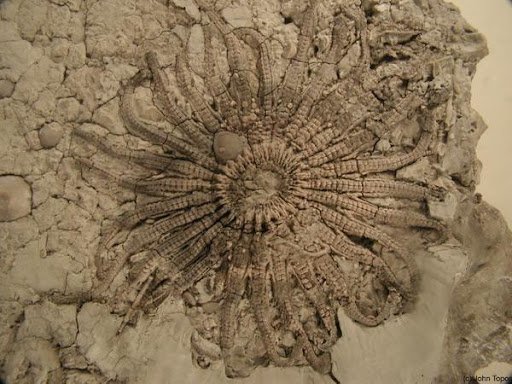
Several fossils have been named after towns in the area such as a brachiopod named after the town of Arkona, Mucrospirifier arkonensis, and the town of Thedford, Mucrospirifer thedfordensis, and even the former town of Widder has a fossilized trilobite named after it, Greenops widderensis.

Latin words are often used when naming fossils. For example, Microcyclus is Latin for “small wheel”. Microcyclus is a small coral that looks like a thin round wheel or button. The brachiopod fossil Petrocrania hamiltoniae is named after a collection of rock units in southern Ontario known as the Hamilton Group, that is mid Devonian in age. There are many fossils that have been found in the area that are named after paleontologists, collectors, and local town names. It is a reflection of why Hungry Hollow is so important and known worldwide.
The rock formation at the bottom of the quarry at Hungry Hollow is the Arkona Formation. It is a bluish coloured shale that is 20 metres thick, and contains fossils such as crinoids, trilobites, brachiopods, gastropods, cephalopods, pelecypods, corals, bryozoans, phyllocarids, starfish, brittlestars, and more.
The rock formation that lies above the Arkona Formation is the Hungry Hollow Member of the Widder Formation. It is two metres thick. The lower (older) half is called the encrinal unit, and is a grey limestone that is rich in crinoid fossils. The upper (younger) half is a soft shale that is rich in fossilized corals, bryozoans, trilobites, and crinoids. Near the base of the Hungry Hollow Member is a layer of black shale that is rich in a fossilized brachiopod species called Leiorhynchus. This black shale represents a period of time when oxygen levels were low.
Above the Hungry Hollow Member is the Widder Formation, which is not exposed in the Hungry Hollow North and South pits. It is, however, exposed on the north and south banks along the Ausable River, which runs between the two quarries. The Widder Formation is exposed high on the cliffs and is approximately 14 metres thick. It is a succession of grey, calcareous shale with thin limestone layers, and contains fossilized trilobites, phyllocarids, cephalopods, pelecypods, crinoids, and gastropods.
A wide variety of microfossils can be found in the area such as fish scales, fish and sharks’ teeth, conodont and scolecodont jaw elements, ostracods, and more.

Throughout the formations you can find fossils that look like gold; however, they are not. These fossils have been pyritized, which occurs in oxygen-poor environments, when bacteria breaks down the original organic material, replacing it with pyrite (FeS2). The Widder Formation contains cephalopods that are completely pyritized, making them look like a gold spear or spike.
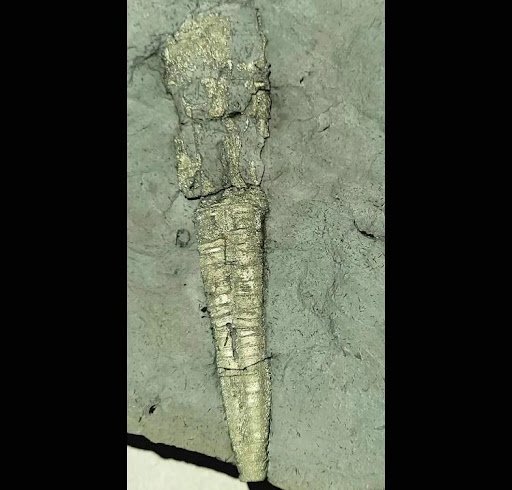
Epifauna are animals that live attached to the seafloor or on the surfaces of other aquatic organisms. The fossils of these types of animals (e.g., bryozoans) are common at Hungry Hollow.
There has been much research done on the fossils and formations at Hungry Hollow. One study in particular used fossilized corals from Hungry Hollow to infer mid-Devonian climate, and the degree of current turbidity (a measure of the cloudiness of water) in the marine environment in which the coral lived. The coral’s eating habits were investigated by cutting corals from the cup to the tip. The thicknesses of the growth layers was an indicator of food availability. Interestingly, if all the lines on the exterior of the coral are present, you can count them (under a microscope) from the tip to the cup to determine its age when it died.
Much information has been collected about the paleoenvironment at Hungry Hollow just by looking at the small, conical shells of Tentaculites, found in the Arkona Formation. If all the fossils of Tentaculites are aligned (end-to-end) in the same orientation, it is a good indicator of the direction of the water current, as the force of the current would have aligned the shells in the same direction.
After a fossil is found (e.g., a trilobite or crinoid), it are cleaned, and a label is made. Cleaning can be taken further by prepping the fossil using an air abrasion unit and microscope. If it’s done slowly, it can bring out the finer details, and this helps gain more information about the fossil. Once the specimen has been cleaned it will make the fossil look alive, and it will be a more valuable specimen. The fossil specimens in these figures are at the Arkona Lions Museum and Information Centre at Rock Glen Conservation Area, Ontario, and were prepped and donated by Stormbed Paleontological and Tony Petropoulos.
Donations to museums can protect and preserve specimens. They can also be used to educate visitors to the museum. There have been several donations of fossils found locally that have been donated to The Arkona Lions Museum and Information Centre at Rock Glen Conservation Area in Arkona, Ontario. For example, Mike and John Topor donated enough fossils to fill three museum cases. They did this in honor of Mr. Charles Southworth, Mr. and Mrs. Edward, and Jean D. Wright, for their contributions to the paleontology of Arkona and Thedford Area. Every fossil that has been donated to the museum has brought the museum to a new level, educating visitors, and elevating its value to the world.
Monetary donations have also made it possible to incorporate technology in the museum, such as microscopes and screens. The Arkona Lions Club works in conjunction with the Ausable Bayfield Conservation Authority to put forth ideas and funds to help improve the museum. Without volunteers that help at the museum it wouldn’t have been possible to have it advance to the next level so quickly. Visitors from all over the world have visited the museum and signed the guest book, showing it is known worldwide.
The Arkona Lions Museum and Information Centre has donated many local fossils to several institutions, such as The Royal Ontario Museum (ROM) in Toronto, University of Michigan Earth Science Museum, and the University of Western Ontario.
Jean Davies Wright and her husband donated their complete fossil collection from the Arkona and Thedford Area to the Smithsonian National Museum of Natural History in Washington D.C. It consisted of 10,242 specimens of which there were 271 different species. The collection took up 57 drawers in the museum! A rare, fossilized fish skull found by Rick Barnard was donated to the University of Michigan Museum of Paleontology.
There are 2- 4 field trips held per year to collect fossils at the Hungry Hollow quarries. The field trips are run by clubs associated with the Central Canadian Federation of Mineralogical Societies (CCFMS), and they ensure that all participants are insured before arriving on the property. The goal of the CCFMS is to promote Earth Sciences, and their annual field trips to Hungry Hollow are a great hands-on way to do so.
Hungry Hollow, and the Arkona area wouldn’t be as famous as they are without the tireless efforts of fossil collectors and paleontologists that continue to find incredible specimens that are (as far we we know) unique to Hungry Hollow.
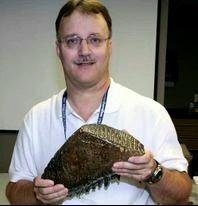
Bob O’Donnell: I started collecting fossils when I was 10 years old and was taken to Arkona, Ontario to go fossil collecting. I was hooked for life! Over 20 years ago I started doing Fossil Presentations as “The Fossil Guy.” I am a past President of The London Gem Mineral and Fossil Society, Communications Director for the CCFMS, Curator for the Arkona Lions Museum and Information Centre at Rock Glen Conservation Area, and field trip leader for field trips to Hungry Hollow for The London Gem Mineral and Fossil Society. I am presently on leave for up to two years to be with family in Kelowna, BC; however, I am still the liaison for the Hungry Hollow quarries in North Middlesex.


